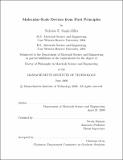Molecular-scale devices from first principles
Author(s)
Singh-Miller, Nicholas E. (Nicholas Edward)
DownloadFull printable version (3.691Mb)
Other Contributors
Massachusetts Institute of Technology. Dept. of Materials Science and Engineering.
Advisor
Nicola Marzari.
Terms of use
Metadata
Show full item recordAbstract
Electronic structure calculations are becoming more widely applied to complex and realistic materials systems and devices, reaching well into the domain of nanotechnology, with applications that include metal-molecule junctions, carbon-nanotube field effect transistors, and nanostructured metals or semiconductors. For such complex systems, characterizing the properties of the elementary building blocks becomes of fundamental importance. In this thesis we employ first-principles calculations based on density-functional theory (DFT) to investigate fundamental properties of molecular-scale devices. We focus initially on the constituent components of these devices (polymers, metal surfaces, carbon nanotubes), following with studies of entire device geometries (nanotube/metal interfaces). We first study a proposed molecular actuating system in which the interaction between oligothiophenes is the driving force behind an electromechanical response. The oligothiophenes are attracted to each other through p-stacking interactions driven by redox reactions. We show that counterions strengthen this interaction further through enhanced screening of the electrostatic repulsion. Many molecular scale devices require contact with a metallic conductor, we also study the fundamental properties of metal surfaces in the slab-supercell approximation; in particular layer relaxation, surface energy, work function, and the effect that slab thickness has on these properties. The surfaces of interest are the low index, (111), (100), and (110) surfaces of Al, Au, Pd, and Pt and the close packed (0001) surface of Ti. (cont.) We show that these properties are well converged for slabs that have between 5 and 10 layers, depending on the property considered and the surface orientation. We then focus on understanding and characterizing devices. Since it is widely proposed that carbon nanotubes (CNTs) could replace Si in future transistor devices, we examine the work function of single-wall CNTs and the effects that covalent functionalization could have in engineering performance. Electrostatic dipoles form due to the charge asymmetries in the functionalized CNT unit cell, and the use of periodic boundary conditions affects our calculations. We correct for these spurious dipole-dipole interactions with a real-space potential derived directly from the solution to Poisson's equation in real-space with open boundary conditions. We find that the functionalizations can be clearly labeled as electropositive and electronegative, and that they decrease or increase the work function of the CNT accordingly. Finally, we join metal surfaces and CNTs to study Schottky barrier heights (SBHs) that form at the interface. We take Al(111) and Pd(111) as examples of low- and high-work function metal surfaces and contact them with the semiconducting (8,0) CNT. We find that in all cases a surface dipole forms that shifts the band structure of the CNT locally. In these systems, we investigate the effects of surface roughness and functionalization on SBHs, and find that controlling the electrostatics at the interface (with functionalization, adsorbates, and device geometry) can lead to further engineering of the SBHs.
Description
Thesis (Ph. D.)--Massachusetts Institute of Technology, Dept. of Materials Science and Engineering, 2009. This electronic version was submitted by the student author. The certified thesis is available in the Institute Archives and Special Collections. Cataloged from student-submitted PDF version of thesis. Includes bibliographical references (p. 155-167).
Date issued
2009Department
Massachusetts Institute of Technology. Department of Materials Science and EngineeringPublisher
Massachusetts Institute of Technology
Keywords
Materials Science and Engineering.